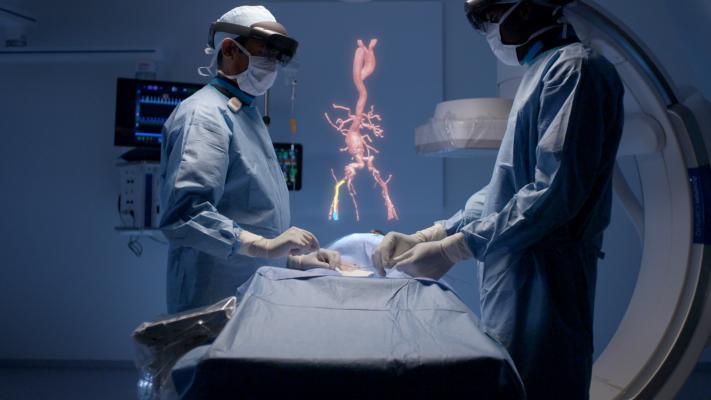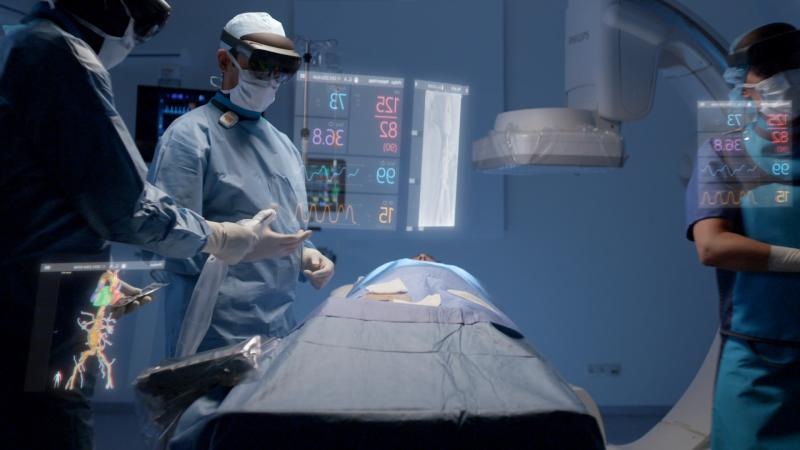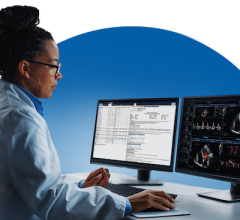
Philips and Microsoft have partnered to develop an augmented reality system to help imporve workflow and procedural navigation in the cath lab. Physicians wearing visors can view and interact with true 3-D holograms above the patient on the table and manipulate the image with voice and hand motion commands to avoid breaking the sterile field.
February 25, 2019 — Philips will unveil a new mixed reality concept developed together with Microsoft that the company says is designed for the operating room of the future. Based on Philips’ Azurion image-guided therapy platform and Microsoft’s HoloLens 2 holographic computing platform, the companies will showcase novel augmented reality applications for image-guided minimally invasive therapies. The technology will debut at Mobile World Congress (MWC) Barcelona, Feb. 25-28 in Barcelona, Spain.
In contrast to open surgery, minimally invasive therapies only require a small incision. Dedicated instruments such as catheters are inserted through the incision and guided to the treatment area, which can include the heart, blood vessels, brain, liver and other major organs. During minimally invasive procedures, physicians cannot directly see and touch the treatment area. Instead they rely on advanced medical imaging technologies such as ultra-low dose X-ray imaging and ultrasound, as well as other navigation technologies, to see inside the patient and guide their actions.
The Philips and Microsoft augmented reality concept, built for HoloLens 2, brings live imaging and other sources of vital data currently displayed on large 2-D screens into a 3-D holographic augmented reality environment that can be ergonomically, easily and intuitively controlled by the physician. The concept is being used to gather further clinical insights to support the development of future commercially-available augmented reality solutions for use in image-guided procedures.
Watch the VIDEO: Editor's Choice of the Most Innovative New Imaging Technology at RSNA 2017 to see the technology in action.
Microsoft unveiled HoloLens 2 at MWC Barcelona. It is a self-contained holographic computer that enables hands-free, heads-up interaction with three-dimensional digital objects. HoloLens 2 builds on the technology of HoloLens and is even more immersive, more comfortable and delivers more value right out of the box, according to Microsoft. The device is complemented by existing and new Azure cloud services, and features built-in artificial intelligence (AI).
Philips launched the Azurion platform globally in February 2017, powered by ConnectOS that allows the integration of advanced digital innovations.
Since its global launch in February 2017, over half a million patients have been treated in more than 80 countries using the Azurion platform, which is powered by Philips’ proprietary ConnectOS and combines technical innovations in both software and hardware. ConnectOS allows the integration of advanced digital innovations on the Azurion platform.
For more information: www.usa.philips.com/healthcare
Related VR and AR Content:
VIDEO: Using Virtual and Augmented Reality to Examine Brain Anatomy and Pathology at MD Anderson
Virtual Reality Boosts Revenues and Patient Understanding
Augmented Reality is Taking Over Radiology Training
VIDEO: Augmented Reality for Surgical Planning Example
Philips and Microsoft Showcase Augmented Reality for Image-Guided Minimally Invasive Therapies
Radiologist Uses Virtual Reality as Interventional Radiology Teaching Tool




 December 09, 2025
December 09, 2025 









